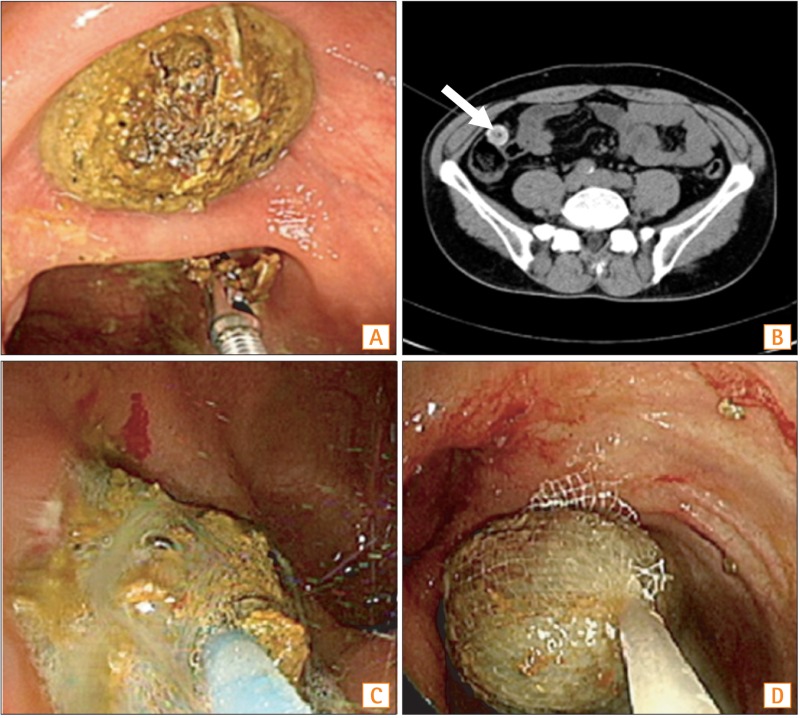

Question: A 40-year-old man visited hospital due to right lower quadrant (RLQ) abdominal pain that had persisted for 8 days. Colonoscopy revealed a hard fecaloma impacted in the cecal diverticulum. We attempted endoscopic removal using alligator grasping forceps, a tripod basket, and net. This attempt failed because the fecaloma was too slippery, large, and hard to grasp (Fig. A). A few days later, the patient was admitted to the hospital emergency room due to recurrent intractable abdominal pain. Abdominal CT revealed a cecal diverticulum with a diameter of 2.7 cm, filled with fecal material and mild edematous wall thickening, and a normal appearance of the appendix (Fig. B). The abdominal pain had not been controlled by antibiotics, including ciprofloxacin, metronidazole, and cimetropium bromide, but was suboptimally controlled by nonsalicylate analgesics such as tramadol. We strongly suspected that localized RLQ abdominal pain was caused by fecaloma of the cecal diverticulum. As we had previously failed in endoscopic mechanical removal of the fecaloma, we tried another method involving a cola injection into the fecaloma. The fecaloma was softened by the cola injection and successfully removed using a net (Fig. C, D). Abdominal pain was dramatically resolved and no other complications were observed. One year later, the patient visited hospital suffering from similar abdominal pain. What do you think could be the cause of his RLQ abdominal pain? What is the next step to control his RLQ abdominal pain?
His intractable RLQ abdominal pain dramatically subsided after endoscopic removal by cola injection. This case provides valuable evidence that fecaloma can be dissolved with a cola injection like bezoars. For the removal of gastric bezoars, methods using cola injection are often reported,1 but the exact mechanism of this process has not yet been elucidated. It is estimated that increasing protease activities inside the stomach by acidifying gastric contents through the release of carbon dioxide bubbles, and the secretolytic activity of sodium hydrogen carbonate, might contribute to the dissolution of gastric bezoars to some extent.1 There is a possibility that a somewhat similar mechanism contributes to the dissolution and softening of fecaloma. In this case, fecaloma can be removed by endoscopic removal. However, feces can be gradually impacted again in the large cecal diverticulum, and abdominal pain can develop repeatedly. Moreover, diverticular complications including bleeding or perforation may occur.2,3 Laparoscopic ileocecectomy is another possible option for management.
References
1. Kim SJ, Lee JH, Chang WI, et al. A case of gastric bezoar treated by an endoscopic Coca-Cola injection. Korean J Gastrointest Endosc. 2007; 34:38–42.
2. Kang J, Chung M. A stercoral perforation of the descending colon. J Korean Surg Soc. 2012; 82:125–127. PMID: 22347716.

3. Sheth AA, Longo W, Floch MH. Diverticular disease and diverticulitis. Am J Gastroenterol. 2008; 103:1550–1556. PMID: 18479497.





 PDF
PDF ePub
ePub Citation
Citation Print
Print


 XML Download
XML Download